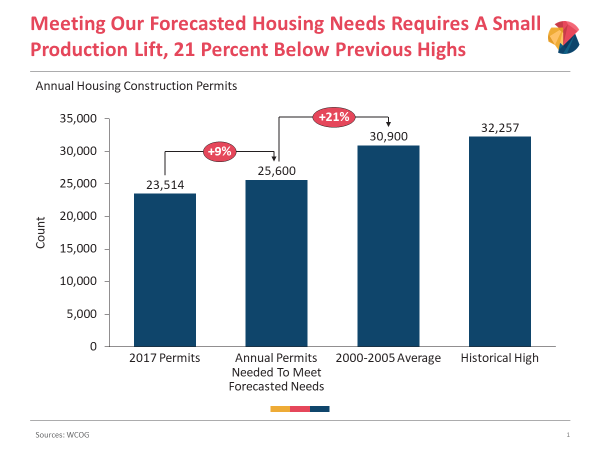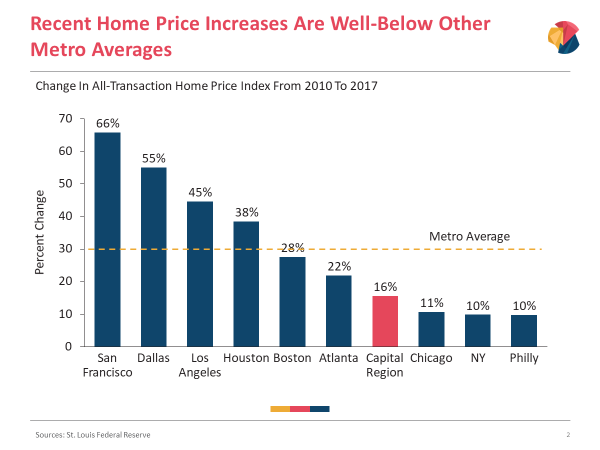A Clear-Eyed Assessment Of Our Housing Challenge
The Capital Region — from Baltimore down to Richmond — is a vibrant and diverse home to residents from all walks of life, from every part of the world, and who, every day, make their unique contributions to our community. While our region is home to some of our country’s greatest moments in history, it is the people living here today who breathe life into it and make it a desirable place to live, work, pursue higher education, and raise a family.
Over the past few decades, however, our region’s supply of high-quality, affordable housing for people across the entire income spectrum has not kept pace with demand. Some families have struggled to find homes in the neighborhoods they love, some residents across the region have felt pushed out of the only communities they’ve ever known, and for some, high monthly housing costs put real strains on the family budget. This is not the spirit of the Capital Region, and we believe it’s high time we take action.
Housing supply statistics can be difficult to understand and, when coupled with exciting opportunities like Amazon’s commitment to the region, reports can often exaggerate the severity of the problem.
The good news: our region is well-positioned to meet our housing challenge. First, addressing that challenge, even with an improved economic growth trajectory, would require achievable increases in housing production generally consistent with levels from the recent past. Second, our region’s housing challenges are nowhere near as severe as those in the country’s hottest housing markets. The Capital Region is actually better positioned to ensure the benefits of Amazon’s commitment, a once-in-a-generation economic opportunity, are widely shared.
Achievable Increases In Current Production — Within Recent Historical Norms — Can Meet Forecasted Needs
The Metropolitan Washington Council of Governments recently found, “To attain the short- and long-term housing needs noted earlier, the region would need a sustained annual housing production of at least 25,600 units per year.”
To hit 25,600, in order to address current shortages, would require a nine percent increase in permits from last year’s levels, which is an increase that still falls below the production levels our region has reached in the past. From 2000 to 2005, we permitted nearly 31,000 units per year on average, peaking at 32,357. An increase to meet forecasted needs, therefore, still leaves us 20 percent below historical highs.

The fact is that, in previous decades, we built housing to match population growth. Over the past ten years, we’ve gotten off course: the population has grown at half the rate it did in decades past, yet our production of housing has fallen behind even that modest uptick in residents. Some of that may be attributed to reduced private sector confidence in our region’s growth trajectory, potentially impacting the willingness to invest in new housing unit production.
An assessment of past performance demonstrates that with concerted effort and focus we can achieve our production needs, even with some increased demand resulting from better economic performance. An increase in production will reduce upward pressure on housing prices and rents, making it easier for every family to find a home. But we also must recognize that to do this in the right way, guided by lessons learned over past decades, we need to be smart about how we do it — facilitating production in the right locations and encouraging investment in multi-family units, higher density, and transportation access that together keeps people living close to where they work.
Increasing our housing supply, through production more in line with historical levels, is a necessary — but achievable — step to ensuring that our region is dynamic and inclusive. This will not happen on its own — it will require a regional approach with action by each jurisdiction. It will require policy changes to leverage unused land, provide ready access to transit, and reduce the cost and speed of production. These are necessary steps for our region, and Amazon’s commitment can serve as the catalyst.
Don’t Fear Opportunity. The Region Is Well-Positioned To Ensure Growth Benefits All.
The reality is that our region needs faster growth. As I wrote recently, our economic growth in the Capital Region is only about half of the growth happening in other leading regional economies. That lag has cost our families up to $5,600 in real income, which I’m sure most of our region’s residents would agree is quite substantial. The good news: we are well-positioned to capitalize on faster growth.
Let’s look at trends in home prices, rents, and overall cost housing burdens.
From 2010 to 2017, the price of buying a home in Los Angeles increased by 45 percent, in Houston by 38 percent, and in Atlanta by 22 percent. But here in the Capital Region, home prices only went up about 16 percent. It’s little wonder the Washington area ranks 3 of 20 on an Urban Institute indicator that measures the number of renters who can afford to become homeowners.

A slower rate of increasing home prices doesn’t just help potential homeowners, it’s good news for renters, too. Last year, while the average rent across the country increased by three percent, average rent in D.C. increased at half that rate, or one and half percent. In fact, the Washington area ranks sixth of 20 on a Zillow indicator of recent increases in median rent (3.8 percent compared to 13.7 percent in NYC, 26 percent in Boston, 38.2 percent in San Francisco).
More broadly, only about one third of families in the Washington area spend more than 30 percent of their income on housing. Baltimore has higher levels, while Richmond has lower. However, other leading regional economies pay far more. Moreover, in the past few years, the Washington area has seen the percent of families cost burdened decline at double the rate of other leading economies. And a number of analyses of the housing impact of Amazon, including from the DC Policy Center and mortgage company Mr. Cooper, suggest that Amazon’s growth in the region would have very small impacts on regional housing prices.

Undoubtedly, we should not look at these facts and determine that no new action is required, quite the contrary. We have real challenges that require a concerted, regional effort with smart policy across jurisdictions and new expanded tools, but our starting point is meaningfully less challenging than other regional markets. We can be ahead of the challenge, instead of playing from far behind.
We should not fear a once-in-a-generation economic opportunity, but, instead, relish an opportunity we are positioned to seize successfully.
Our Path Forward: Preserve, Produce, And Protect So Housing Is Affordable For All
While I am optimistic about our ability to provide high-quality, affordable housing for all, it’s clear we need a plan to move solutions. Four weeks ago, we announced a Regional Housing Framework. In partnership with the Urban Institute, this framework represents the first time the business community — represented by our CEOs who collectively employ nearly 200,000 people in the region — is creating and demanding housing solutions. The Framework’s three principles are:
- Preserve existing affordable housing in all communities, including opportunity-rich and revitalizing areas.
- Produce more housing across the income spectrum and in communities throughout the region so that all jurisdictions contribute to and benefit from meeting everyone’s housing needs.
- Protect both renters and homebuyers from discrimination and involuntary displacement.
Working together, the region can meet our affordable housing challenge. We know what to do and how to do it. It’s time we act.
This post wad authored by former Greater Washington Partnership CEO, Jason Miller
